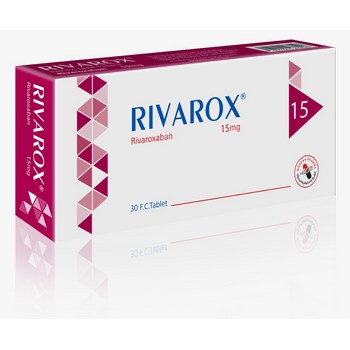- Increased Risk of Thrombotic Events after Premature
Discontinuation:
If RIVAROX® is discontinued for a reason other than pathological bleeding or
completion of a course of therapy, consider coverage with another anticoagulant.
- Risk of Bleeding: and can cause serious or fatal bleeding.
• Concomitant use of other drugs that impair hemostasis increases the risk of bleeding
(e.g. aspirin, antiplatelet; fibrinolytic therapy and NSAIDs).
• the following conditions are at increased risk of bleeding with the use of
RIVAROX® for primary VTE prophylaxis: history of bronchiectasis, pulmonary
cavitation, or pulmonary hemorrhage, active cancer (i.e. undergoing acute,
in-hospital cancer treatment), active gastroduodenal ulcer in the three months prior
to treatment, history of bleeding in the three months prior to treatment, or dual
antiplatelet therapy.
- Spinal/Epidural Anesthesia or Puncture: is employed, patients are at risk of
developing an epidural or spinal hematoma which can result in long-term or
permanent paralysis.
Tell your doctor immediately if you experience skin reactions such as:
• Spreading intense skin rash, blisters or mucosal lesions, e.g. in the mouth or eyes
(Stevens Johnson syndrome/toxic epidermal necrolysis).
• A drug reaction that causes rash, fever, inflammation of internal organs, hematologic
abnormalities and systemic illness (DRESS syndrome).
Tell your doctor immediately if you experience any of the following side effects:
• Swelling of the face, lips, mouth, tongue or throat; difficulty swallowing; hives and
breathing difficulties; sudden drop in blood pressure.
Overall list of possible side effects:
• reduction in red blood cells which can make the skin pale and cause weakness or
breathlessness
• bleeding in the stomach or bowel, urogenital bleeding, nose bleed, bleeding in the
gum.
• bleeding into the eye (including bleeding from the whites of the eyes)
• bleeding into tissue or a cavity of the body (hematoma, bruising)
• coughing up blood.
• bleeding from the skin or under the skin.
• bleeding following an operation.
• oozing of blood or fluid from surgical wound.
• swelling in the limbs.
• pain in the limbs.
• impaired function of the kidneys (may be seen in tests performed by your doctor).
• fever.
• stomach ache, indigestion, feeling or being sick, constipation, diarrhea.
• low blood pressure (symptoms may be feeling dizzy or fainting when standing up).
• decreased general strength and energy (weakness, tiredness), headache, dizziness
• rash, itchy skin.
• blood tests may show an increase in some liver enzymes.
• fainting.
this includes any possible side effects not listed in this leaflet. you can report side
effect directly via the: hhttp\\www.modernpharmaye.com\adrs.pdf
and send to us on: adrs@modernpharmaye.com
- Use in Patients with Renal Impairment:
Periodically assess renal function as clinically indicated (i.e., more frequently in
situations in which renal function may decline) and adjust therapy accordingly [see
indications, Dosage and Administration table].
- Use in Patients with Hepatic Impairment:
No clinical data are available for patients with severe hepatic impairment.
- Use with P-gp and Strong CYP3A Inhibitors or Inducers:
Avoid concomitant use of RIVAROX® with known combined P-gp and
strong CYP3A inhibitors (e.g. ketoconazole and ritonavir) or strong CYP3A inducer
(e.g., carbamazepine, phenytoin, rifampin, St. John’s wort).


